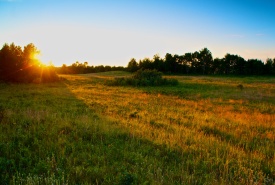Maymont 5

Sunset at Maymont Property, SK (Photo by Dabbs)
High in the Columbia Icefield in the Canadian Rockies, water from melting glaciers feeds the headwaters of the North Saskatchewan River. Flowing southeast, it crosses through Alberta and Saskatchewan and into Manitoba, forming part of a large watershed that spans the Prairie provinces.
On the river's south bank, about 100 kilometres northwest from Saskatoon, is the 136-acre (55-hectare) Maymont 5 property. The undulating land slopes north towards the hardwood forests on the bank of the North Saskatchewan River. The diverse habitats on the property provide homes for a variety of mammals, waterfowl and grassland birds.
Ecological significance
The West Parklands Natural Area is one of the best remaining landscapes along the forest fringe of western Canada. Straddling the transition between open grasslands to the south and closed forests to the north, it is an area of high natural diversity. This area is classified within the aspen parkland forest type.
The natural area contains three Important Bird Areas and a Biosphere Reserve. The North Saskatchewan River cuts west to east through the West Parklands, which further enhances its natural diversity.
Threats
The original West Parklands has lost almost half of its 5.2 million acres (2.1 million hectares) of natural habitat, largely to agriculture. Threats to the remaining fragmented lands and water are anticipated to increase over the next decade or two.
In the shorter term, threats to biodiversity in the natural area will be compounded by the impending removal of formal protection for up to one-third of the 247,000 acres (99,900 hectares) of native lands in the natural area currently listed under the Wildlife Habitat Protection Act.
A natural partnership
Thanks in part to generous funding from TD Bank Group (TD) through the TD Forests program, this property has now been protected in perpetuity. Its conservation adds to the Nature Conservancy of Canada's (NCC's) 2,200 acres (890 hectares) of adjacent protected lands in the immediate area.
The TD Forests program will increase the amount of forested lands protected and cared for by the Nature Conservancy of Canada. Since 2012, has helped NCC protect over 40,000 acres (16,000 hectares) of important forested habitats across Canada. TD and NCC are also engaging more Canadians in the mission to conserve our forests, which will safeguard not just the trees, but all the living things that rely on forested habitats.




